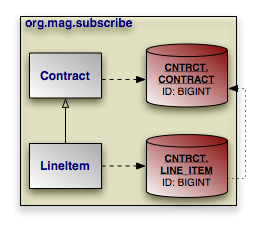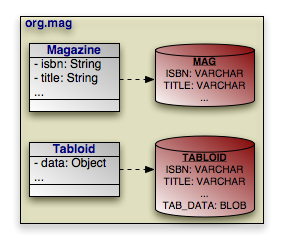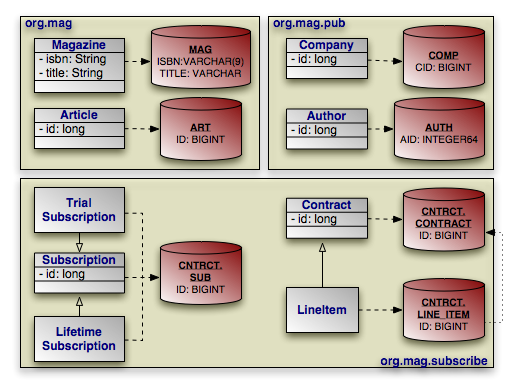In the 1990's programmers coined the term impedance mismatch to describe the difficulties in bridging the object and relational worlds. Perhaps no feature of object modeling highlights the impedance mismatch better than inheritance. There is no natural, efficient way to represent an inheritance relationship in a relational database.
Luckily, JPA gives you a choice of inheritance strategies, making
the best of a bad situation. The base entity class defines the inheritance
strategy for the hierarchy with the Inheritance
annotation. Inheritance has the following properties:
InheritanceType strategy: Enum value declaring the inheritance strategy for the hierarchy. Defaults toInheritanceType.SINGLE_TABLE. We detail each of the available strategies below.
The corresponding XML element is inheritance, which has a
single attribute:
strategy: One ofSINGLE_TABLE,JOINED, orTABLE_PER_CLASS.
The following sections describe JPA's standard inheritance strategies.
Note
OpenJPA allows you to vary your inheritance strategy for each class, rather than forcing a single strategy per inheritance hierarchy. See Section 7, “ Additional JPA Mappings ” in the Reference Guide for details.
The InheritanceType.SINGLE_TABLE strategy maps all classes in
the hierarchy to the base class' table.
 |
In our model, Subscription is mapped to the
CNTRCT.SUB table. LifetimeSubscription, which
extends Subscription, adds its field data to this table
as well.
Example 12.5. Single Table Mapping
@Entity
@Table(name="SUB", schema="CNTRCT")
@Inheritance(strategy=InheritanceType.SINGLE_TABLE)
public class Subscription {
...
}
@Entity(name="Lifetime")
public class LifetimeSubscription
extends Subscription {
...
}
The same metadata expressed in XML form:
<entity class="org.mag.subcribe.Subscription">
<table name="SUB" schema="CNTRCT"/>
<inheritance strategy="SINGLE_TABLE"/>
...
</entity>
<entity class="org.mag.subscribe.LifetimeSubscription">
...
</entity>
Single table inheritance is the default strategy. Thus, we could omit the
@Inheritance annotation in the example above and get the same
result.
Single table inheritance mapping is the fastest of all inheritance models, since
it never requires a join to retrieve a persistent instance from the database.
Similarly, persisting or updating a persistent instance requires only a single
INSERT or UPDATE statement. Finally,
relations to any class within a single table inheritance hierarchy are just as
efficient as relations to a base class.
The larger the inheritance model gets, the "wider" the mapped table gets, in that for every field in the entire inheritance hierarchy, a column must exist in the mapped table. This may have undesirable consequence on the database size, since a wide or deep inheritance hierarchy will result in tables with many mostly-empty columns.
The InheritanceType.JOINED strategy uses a different table
for each class in the hierarchy. Each table only includes state declared in its
class. Thus to load a subclass instance, the JPA implementation must
read from the subclass table as well as the table of each ancestor class, up to
the base entity class.
 |
PrimaryKeyJoinColumn annotations tell the JPA
implementation how to join each subclass table record to the corresponding
record in its direct superclass table. In our model, the LINE_ITEM.ID
column joins to the CONTRACT.ID column. The
PrimaryKeyJoinColumn annotation has the following
properties:
String name: The name of the subclass table column. When there is a single identity field, defaults to that field's column name.String referencedColumnName: The name of the superclass table column this subclass table column joins to. When there is a single identity field, defaults to that field's column name.String columnDefinition: This property has the same meaning as thecolumnDefinitionproperty on theColumnannotation, described in Section 3, “ Column ”.
The XML equivalent is the primary-key-join-column element.
Its attributes mirror the annotation properties described above:
namereferenced-column-namecolumn-definition
The example below shows how we use InheritanceTable.JOINED
and a primary key join column to map our sample model according to the diagram
above. Note that a primary key join column is not strictly needed, because there
is only one identity column, and the subclass table column has the same name as
the superclass table column. In this situation, the defaults suffice. However,
we include the primary key join column for illustrative purposes.
Example 12.6. Joined Subclass Tables
@Entity
@Table(schema="CNTRCT")
@Inheritance(strategy=InheritanceType.JOINED)
public class Contract
extends Document {
...
}
public class Subscription {
...
@Entity
@Table(name="LINE_ITEM", schema="CNTRCT")
@PrimaryKeyJoinColumn(name="ID", referencedColumnName="ID")
public static class LineItem
extends Contract {
...
}
}
The same metadata expressed in XML form:
<entity class="org.mag.subcribe.Contract">
<table schema="CNTRCT"/>
<inheritance strategy="JOINED"/>
...
</entity>
<entity class="org.mag.subscribe.Subscription.LineItem">
<table name="LINE_ITEM" schema="CNTRCT"/>
<primary-key-join-column name="ID" referenced-column-name="PK"/>
...
</entity>
When there are multiple identity columns, you must define multiple
PrimaryKeyJoinColumns using the aptly-named
PrimaryKeyJoinColumns annotation. This annotation's value is an
array of PrimaryKeyJoinColumn s. We could rewrite
LineItem's mapping as:
@Entity
@Table(name="LINE_ITEM", schema="CNTRCT")
@PrimaryKeyJoinColumns({
@PrimaryKeyJoinColumn(name="ID", referencedColumnName="ID")
})
public static class LineItem
extends Contract {
...
}
In XML, simply list as many primary-key-join-column elements
as necessary.
The joined strategy has the following advantages:
Using joined subclass tables results in the most normalized database schema, meaning the schema with the least spurious or redundant data.
As more subclasses are added to the data model over time, the only schema modification that needs to be made is the addition of corresponding subclass tables in the database (rather than having to change the structure of existing tables).
Relations to a base class using this strategy can be loaded through standard joins and can use standard foreign keys, as opposed to the machinations required to load polymorphic relations to table-per-class base types, described below.
Aside from certain uses of the table-per-class strategy described below, the
joined strategy is often the slowest of the inheritance models. Retrieving any
subclass requires one or more database joins, and storing subclasses requires
multiple INSERT or UPDATE statements. This
is only the case when persistence operations are performed on subclasses; if
most operations are performed on the least-derived persistent superclass, then
this mapping is very fast.
Note
When executing a select against a hierarchy that uses joined subclass table inheritance, you must consider how to load subclass state. Section 8, “ Eager Fetching ” in the Reference Guide describes OpenJPA's options for efficient data loading.
Like the JOINED strategy, the
InheritanceType.TABLE_PER_CLASS strategy uses a different table for
each class in the hierarchy. Unlike the JOINED strategy,
however, each table includes all state for an instance of the corresponding
class. Thus to load a subclass instance, the JPA implementation must
only read from the subclass table; it does not need to join to superclass
tables.
 |
Suppose that our sample model's Magazine class has a
subclass Tabloid. The classes are mapped using the
table-per-class strategy, as in the diagram above. In a table-per-class mapping,
Magazine's table MAG contains all
state declared in the base Magazine class.
Tabloid maps to a separate table, TABLOID. This
table contains not only the state declared in the Tabloid
subclass, but all the base class state from Magazine as
well. Thus the TABLOID table would contain columns for
isbn, title, and other
Magazine fields. These columns would default to the names used in
Magazine's mapping metadata.
Section 8.3, “
Embedded Mapping
” will show you how to use
AttributeOverrides and AssociationOverride
s to override superclass field mappings.
Example 12.7. Table Per Class Mapping
@Entity
@Table(name="MAG")
@Inheritance(strategy=InheritanceType.TABLE_PER_CLASS)
public class Magazine {
...
}
@Entity
@Table(name="TABLOID")
public class Tabloid
extends Magazine {
...
}
And the same classes in XML:
<entity class="org.mag.Magazine">
<table name="MAG"/>
<inheritance strategy="TABLE_PER_CLASS"/>
...
</entity>
<entity class="org.mag.Tabloid">
<table name="TABLOID"/>
...
</entity>
The table-per-class strategy is very efficient when operating on instances of a known class. Under these conditions, the strategy never requires joining to superclass or subclass tables. Reads, joins, inserts, updates, and deletes are all efficient in the absence of polymorphic behavior. Also, as in the joined strategy, adding additional classes to the hierarchy does not require modifying existing class tables.
Polymorphic relations to non-leaf classes in a table-per-class hierarchy have
many limitations. When the concrete subclass is not known, the related object
could be in any of the subclass tables, making joins through the relation
impossible. This ambiguity also affects identity lookups and queries; these
operations require multiple SQL SELECTs (one for each
possible subclass), or a complex UNION.
Note
Section 12.1, “ Table Per Class ” in the Reference Guide describes the limitations OpenJPA places on table-per-class mapping.
Now that we have covered JPA's inheritance strategies, we can update our mapping document with inheritance information. Here is the complete model:
 |
And here is the corresponding mapping metadata:
Example 12.8. Inheritance Mapping
package org.mag;
@Entity
@IdClass(Magazine.MagazineId.class)
@Table(name="MAG")
public class Magazine {
@Column(length=9)
@Id private String isbn;
@Id private String title;
...
public static class MagazineId {
...
}
}
@Entity
@Table(name="ART", uniqueConstraints=@Unique(columnNames="TITLE"))
@SequenceGenerator(name="ArticleSeq", sequenceName="ART_SEQ")
public class Article {
@Id
@GeneratedValue(strategy=GenerationType.SEQUENCE, generator="ArticleSeq")
private long id;
...
}
package org.mag.pub;
@Entity
@Table(name="COMP")
public class Company {
@Column(name="CID")
@Id private long id;
...
}
@Entity
@Table(name="AUTH")
public class Author {
@Id
@GeneratedValue(strategy=GenerationType.TABLE, generator="AuthorGen")
@TableGenerator(name="AuthorGen", table="AUTH_GEN", pkColumnName="PK",
valueColumnName="AID")
@Column(name="AID", columnDefinition="INTEGER64")
private long id;
...
}
@Embeddable
public class Address {
...
}
package org.mag.subscribe;
@MappedSuperclass
public abstract class Document {
@Id
@GeneratedValue(strategy=GenerationType.IDENTITY)
private long id;
...
}
@Entity
@Table(schema="CNTRCT")
@Inheritance(strategy=InheritanceType.JOINED)
public class Contract
extends Document {
...
}
@Entity
@Table(name="SUB", schema="CNTRCT")
@Inheritance(strategy=InheritanceType.SINGLE_TABLE)
public class Subscription {
@Id
@GeneratedValue(strategy=GenerationType.IDENTITY)
private long id;
...
@Entity
@Table(name="LINE_ITEM", schema="CNTRCT")
@PrimaryKeyJoinColumn(name="ID", referencedColumnName="ID")
public static class LineItem
extends Contract {
...
}
}
@Entity(name="Lifetime")
public class LifetimeSubscription
extends Subscription {
...
}
@Entity(name="Trial")
public class TrialSubscription
extends Subscription {
...
}
The same metadata expressed in XML form:
<entity-mappings xmlns="http://java.sun.com/xml/ns/persistence/orm"
xmlns:xsi="http://www.w3.org/2001/XMLSchema-instance"
xsi:schemaLocation="http://java.sun.com/xml/ns/persistence/orm orm_1_0.xsd"
version="1.0">
<mapped-superclass class="org.mag.subscribe.Document">
<attributes>
<id name="id">
<generated-value strategy="IDENTITY"/>
</id>
...
</attributes>
</mapped-superclass>
<entity class="org.mag.Magazine">
<table name="MAG"/>
<id-class="org.mag.Magazine.MagazineId"/>
<attributes>
<id name="isbn">
<column length="9"/>
</id>
<id name="title"/>
...
</attributes>
</entity>
<entity class="org.mag.Article">
<table name="ART">
<unique-constraint>
<column-name>TITLE</column-name>
</unique-constraint>
</table>
<sequence-generator name="ArticleSeq" sequence-name="ART_SEQ"/>
<attributes>
<id name="id">
<generated-value strategy="SEQUENCE" generator="ArticleSeq"/>
</id>
...
</attributes>
</entity>
<entity class="org.mag.pub.Company">
<table name="COMP"/>
<attributes>
<id name="id">
<column name="CID"/>
</id>
...
</attributes>
</entity>
<entity class="org.mag.pub.Author">
<table name="AUTH"/>
<attributes>
<id name="id">
<column name="AID" column-definition="INTEGER64"/>
<generated-value strategy="TABLE" generator="AuthorGen"/>
<table-generator name="AuthorGen" table="AUTH_GEN"
pk-column-name="PK" value-column-name="AID"/>
</id>
...
</attributes>
</entity>
<entity class="org.mag.subcribe.Contract">
<table schema="CNTRCT"/>
<inheritance strategy="JOINED"/>
<attributes>
...
</attributes>
</entity>
<entity class="org.mag.subcribe.Subscription">
<table name="SUB" schema="CNTRCT"/>
<inheritance strategy="SINGLE_TABLE"/>
<attributes>
<id name="id">
<generated-value strategy="IDENTITY"/>
</id>
...
</attributes>
</entity>
<entity class="org.mag.subscribe.Subscription.LineItem">
<table name="LINE_ITEM" schema="CNTRCT"/>
<primary-key-join-column name="ID" referenced-column-name="PK"/>
...
</entity>
<entity class="org.mag.subscribe.LifetimeSubscription" name="Lifetime">
...
</entity>
<entity class="org.mag.subscribe.TrialSubscription" name="Trial">
...
</entity>
</entity-mappings>